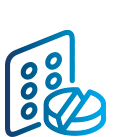Advising customers
Customers might not know what is causing their sore throat and whether they should see their GP. Here's how you can help.
Sore throat symptoms1
Customers may say that they have a painful throat, it hurts to swallow, or their throat feels dry or scratchy. They may have redness at the back of the throat and the neck glands may be swollen. They may also have bad breath or a mild cough. Most sore throats are a symptom of a viral or bacterial infection, such as a cold/flu or laryngitis.
GPs will not routinely prescribe antibiotics. This is part of the agenda to reduce antibiotic resistance and is also the reason why there are no longer antibiotic ingredients in OTC throat lozenges. They will use the FeverPAIN (see below) or Centor score to assess whether to prescribe an antibiotic.2
Fever
- P urulence (pus on the tonsils)
- A ttend within 3 days or less (i.e. rapid onset of symptoms)
- I nflamed tonsils (severe)
- N o cough/coryza (inflammation of nasal mucous membrane)
Self-care advice1,2

Advise them to take paracetamol or ibuprofen (if appropriate)

Drink plenty of fluids (not hot drinks), eat cool or soft foods, and rest

Gargle with warm, salty water (adults only) and suck ice cubes/lollies or hard sweets*

Recommend medicated lozenges to help ease the pain*
* Young children shouldn't be given anything small and hard to suck due to risk of choking
When to refer
Refer customers with the following to the GP:1
- Symptoms that don't improve after a week
- Recurrent or severe sore throats
- An associated high fever or feeling hot/shivery
- Those with a weakened immune system (e.g. on chemotherapy)
Urgent referral (999):1 Customers with: difficulty swallowing/breathing; drooling; making a high-pitched sound when breathing; severe symptoms that are getting worse quickly should be referred as an emergency.
Note: Sometimes a sore throat can be a sign of a blood disorder in customers taking certain medications such as carbimazole, so refer customers taking medicines to the pharmacist.